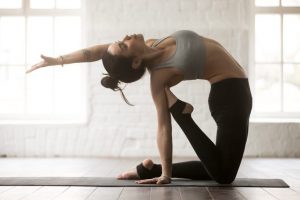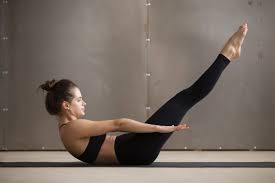 Pilates began in the early 1900s in Germany when the young, frail Joseph Pilates took up body-building to improve his strength. He succeeded so well that by his teens he was posing as a body model. He went on to become a keen gymnast, skier, boxer, diver and circus performer.
Pilates began in the early 1900s in Germany when the young, frail Joseph Pilates took up body-building to improve his strength. He succeeded so well that by his teens he was posing as a body model. He went on to become a keen gymnast, skier, boxer, diver and circus performer.
During World War 1, he was interned in England and worked as a nurse. He devised exercises using hospital bed springs so that patients could tone their muscles even before they could get out of bed.
 Pilates is an exercise system designed to improve flexibility and strength without building bulk, and therefore much preferred by women. It is very popular with dancers. It is a series of controlled movements for the body and mind, performed on specific equipment or mats. Pilates is kind-of a cross between yoga, calisthenics and stretching, being more dynamic than yoga.
Pilates is an exercise system designed to improve flexibility and strength without building bulk, and therefore much preferred by women. It is very popular with dancers. It is a series of controlled movements for the body and mind, performed on specific equipment or mats. Pilates is kind-of a cross between yoga, calisthenics and stretching, being more dynamic than yoga.
Pilates does not involve jumping around wildly to loud music. Rather, each movement involves relaxed concentration and control, to ensure the correct position, breathing and body alignment. Using your body correctly during exercise should train you into the correct way to use your body. Your posture should improve, and muscle tensions ease away.
Fundamentals of Pilates
- BreathingBreathe deeply and rhythmically. Breathe out with the effort, to help you relax into the position. Breathing in during a position tenses your body.
- ConcentrationDon’t be distracted by the outside world, but concentrate on your mind and body working together.
- Girdle of strengthThe Girdle of Strength refers to the set of muscles controlling the back, abdomen and buttocks. Developing these muscles is a key part of Pilates. The back, abdomen and buttocks are the source of strength for many exercises and protects the back muscles from unnecessary strain.
- Flowing MovementPositions flow slowly and naturally into each other. Your breathing sets the pace of your exercises.
- RelaxationDo relaxation exercises at the end of each session, to restore energy levels and peace of mind.
Posture
Posture is all-important in Pilates, and should be kept in mind during all forms of exercise, whether at the gym, pilates, going for a walk and more.
Most people hold their body in a slouch, instead of the correct long, relaxed straight stance.
In Pilates the head should be relaxed, chin slightly down, to lengthen the back of the neck, which should be in line with the spine.
Shoulders should be even in height, neither slouched forward or pulled back. Arm movement should start in the muscles of the back below the shoulder blades. Shoulders should not necessarily lift up just because the arms are.
Your spine should be long, with the coccyx pointing towards the floor. Your navel should be drawn in towards your spine, and pelvic muscles pulled up so your butt doesn’t stick out.
Your feet should point forwards, with equal weight on each leg.
Sample Pilates Exercise – Arm and Leg Stretch
Lie on your stomach with a small pillow under your abdominal muscles.
Stretch your arms above your head with shoulders relaxed and palms facing the floor.
Place your feet hip-width apart, with knees facing the floor.
Breathe in, and as you breathe out, draw your navel towards your spine and hold it there for the rest of the position.
Breathe in, and as you breathe out, stretch out your right arm and left leg as far out as you can, aiming for length rather than height. Then breathe in and lower them to the floor.
Breathe in, and repeat for left arm and right leg.
Make sure there is no tension in your neck or shoulders and navel still pulled in. You can repeat the exercise up to five times, before relaxing.
Pilates is an excellent exercise for strength and flexibility.